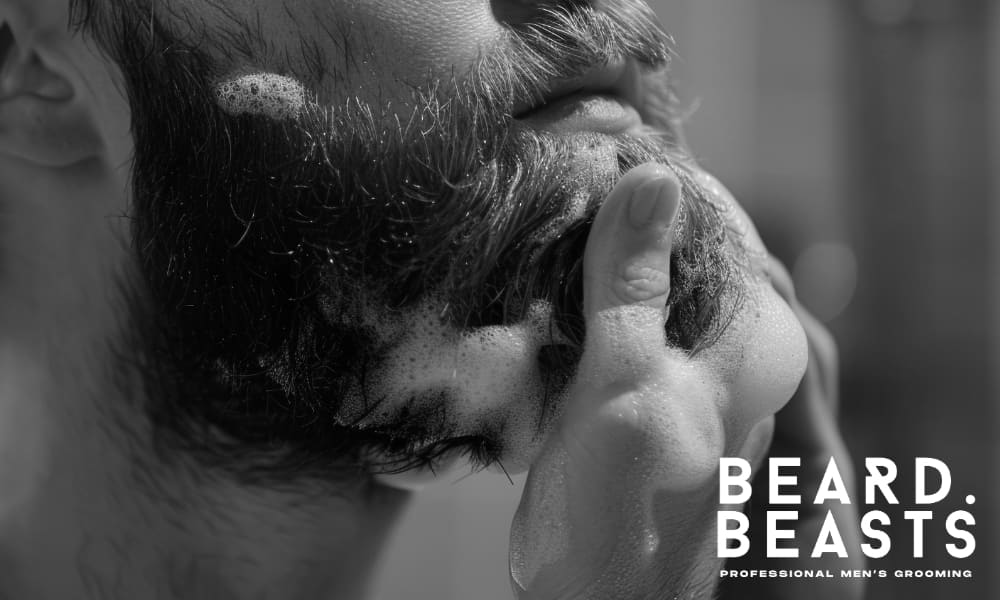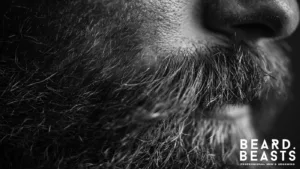If beard hair sticking out is messing with your beard style, you’re not alone; those stray beard hairs can quickly turn a well-groomed beard into a frustrating mess. Thankfully, taming unruly beard hair is achievable with the right approach and tools.
This guide will provide you with practical, professional techniques to maintain a sleek, controlled beard that complements your hairstyle and overall look. Whether your beard is short, medium, or long, you’ll find tailored tips to keep every hair in place.
Why Does Beard Hair Stick Out?

Many men find themselves dealing with beard hair sticking out, which can detract from an otherwise well-groomed appearance. To address this common issue effectively, it’s essential to understand the underlying causes. Here’s a breakdown of the primary factors:
Natural Beard Growth Patterns:
Every beard is unique, showing distinct growth patterns. Some men are fortunate to have naturally straight and easily manageable beard hair, while others suffer with curls, kinks, and varying beard hair thickness that leads to stray beard hairs. This is particularly noticeable during the initial growth stages, where shorter hairs tend to be more rigid and resistant to styling.
Lack Of Moisture:
Dry and brittle beard hair is highly susceptible to sticking out and appearing unruly. When both the beard hair and the underlying skin lack moisture, they become rough and difficult to manage. A lack of moisture can cause individual hairs to curl, become wiry, and resist attempts at styling.
Improper Grooming Practices:
Improper or inconsistent grooming routines can significantly contribute to unruly beard hair. Key factors include:
- Infrequent Trimming: Allowing too much time between trims enables stray hairs to disrupt the beard’s intended shape and overall uniformity.
- Use of Harsh Cleansing Agents: Regular hair shampoos often contain harsh chemicals that strip the beard of its natural oils, leading to excessive dryness.
- Neglect of Daily Brushing and Combing: Consistent brushing and combing are crucial for smoothing beard hairs, distributing natural oils, and minimizing the occurrence of stray strands.
Environmental and External Factors:
External influences, such as environmental conditions and physical interactions, can also affect beard hair behavior. These include:
- Exposure to Wind: Strong winds can displace beard hairs, resulting in a messy and unkempt appearance.
- Fluctuations in Weather Conditions: Both excessively dry and humid weather can alter the texture and manageability of beard hair.
- Friction from Clothing and Accessories: Contact with high collars, scarves, or other accessories can cause friction, leading to misalignment and stray hairs.
Understanding these contributing factors is crucial for developing an effective grooming routine and achieving a well-maintained, polished beard.
How To Tame Beard Hair Sticking Out: Step-by-Step Guide

Shall we get rid of those beard hairs sticking out? Here’s a simple guide to get your beard looking smooth and neat.
Step 1: Wash Your Beard
Always start with a clean beard. Use a shampoo made for beards to wash away dirt and oil. A clean beard helps products work better and keeps your beard healthy.
- Tip: Don’t use regular hair shampoo. It can dry out your beard, making hairs stick out more.
Step 2: Put On Beard Oil or Beard Butter
Moisture stops hairs from sticking out. Beard oil or butter softens your beard and adds a little weight to keep hairs down.
- Beard Oil: Good for making short beards soft and shiny.
- Beard Butter: Good for longer beards, adds moisture and a light hold.
- How to put it on:
- Put a few drops of oil or a small amount of butter in your hand.
- Rub your hands together to warm it up.
- Rub it into your beard, getting it on the hair and skin.
- Make sure it’s spread evenly.
Step 3: Brush or Comb Your Beard
A brush or comb helps spread the oil or butter and trains your hairs to lay flat.
- Brush: Good for short beards, helps clean the skin.
- Comb: Good for longer beards, helps untangle hairs.
- How to do it: Always brush or comb down, the way your hair grows.
Step 4: Trim Hairs That Stick Out
Sometimes, you need to trim hairs to stop them from sticking out. Use good beard scissors or a trimmer.
- Trim only the hairs that stick out: Don’t trim too much.
- Trim along your beard’s shape: Keep it looking natural.
Step 5: Use Beard Balm to Hold Hairs Down
Beard balm helps keep your beard in place. It also makes your beard soft.
- How to use beard balm:
- Put a little balm in your hand and warm it up.
- Rub it into your beard, where hairs stick out.
- Smooth it down with your hands, or use a brush.
Pro Tip: Avoid Heat Styling Tools. Using blow dryers or straighteners can damage beard hair, causing dryness and breakage, which leads to more stray hairs. Instead, gently pat your beard dry with a towel and allow it to air dry, promoting healthier hair.
If you follow these steps consistently each day, you’ll not only notice a significant reduction in those pesky beard hairs sticking out, but you’ll also achieve a healthier, more manageable beard that enhances your overall appearance and boosts your confidence.
Tips for Different Beard Lengths: Stop Those Hairs From Sticking Out

No matter if your beard is short, medium, or long, you can learn how to keep those stray hairs in check. Here’s how to do it based on your beard’s length.
Short Beards: Every Hair Matters
For short beards, where every hair is noticeable, maintaining a sharp and polished look requires precision, as even a single beard hair sticking out can disrupt the overall appearance.
- Daily Care: Use a beard brush with stiff bristles to keep hairs in place and clean your skin.
- Oil Every Day: Put on a light beard oil to keep your beard soft and stop hairs from sticking out.
- Trim Often: Use a trimmer with a short guide to keep your beard even. Trim every few days.
- Use a Little Balm: Even short beards can use a bit of balm to hold hairs down.
- Quick Fix: Keep a small comb with you to fix stray hairs during the day.
Medium Beards: Keep It Balanced
Medium-length beards offer versatility in styling, but they also present increased opportunities for beard hair sticking out, making it essential to strike a balance between maintaining volume and ensuring control.
- Use Beard Butter: Beard butter adds moisture and keeps hairs in place.
- Brush and Comb: Use a wide comb to untangle, then a brush to smooth.
- Trim Every 1-2 Weeks: Keep your beard shaped by trimming regularly.
- Use Beard Balm: Put on some balm to keep your beard looking neat.
- Shape the Sides: Focus on keeping the sides of your beard from puffing out.
Long Beards: Control Is Key
Long beards, while making a strong style statement, demand careful maintenance to prevent beard hair sticking out, which can quickly turn a distinguished look into one that appears disheveled.
- Deep Conditioning: Use beard butter or conditioner once a week to keep your beard soft.
- Comb and Brush Daily: Start with a beard comb to untangle, then brush to smooth.
- Use More Beard Balm: Put on a good amount of balm to hold hairs down and nourish your beard.
- Trim Carefully: Trim the ends and any split hairs with beard scissors.
No matter how long your beard is, you need to be consistent. Use the right products, groom your beard regularly, and pay attention to details to keep your beard looking neat every day
Wrapping it up: Getting rid of beard hairs sticking out.
A neat beard isn’t just about looks; it’s about feeling good and showing your best self. When beard hair sticks out, it can ruin even the best hairstyle. But don’t worry, you can easily manage stray beard hairs with the right grooming, products, and a little patience. Doing these steps daily will give you a polished, professional look.
Remember, every beard is different. You might need to try a few things to find what works best. Being consistent is key. Add these steps to your daily routine and adjust them as needed. You’ll see a big difference in how smooth and manageable your beard becomes, and you’ll get rid of those annoying hairs sticking out. With the right care, your beard will be a great feature that makes you feel confident.





